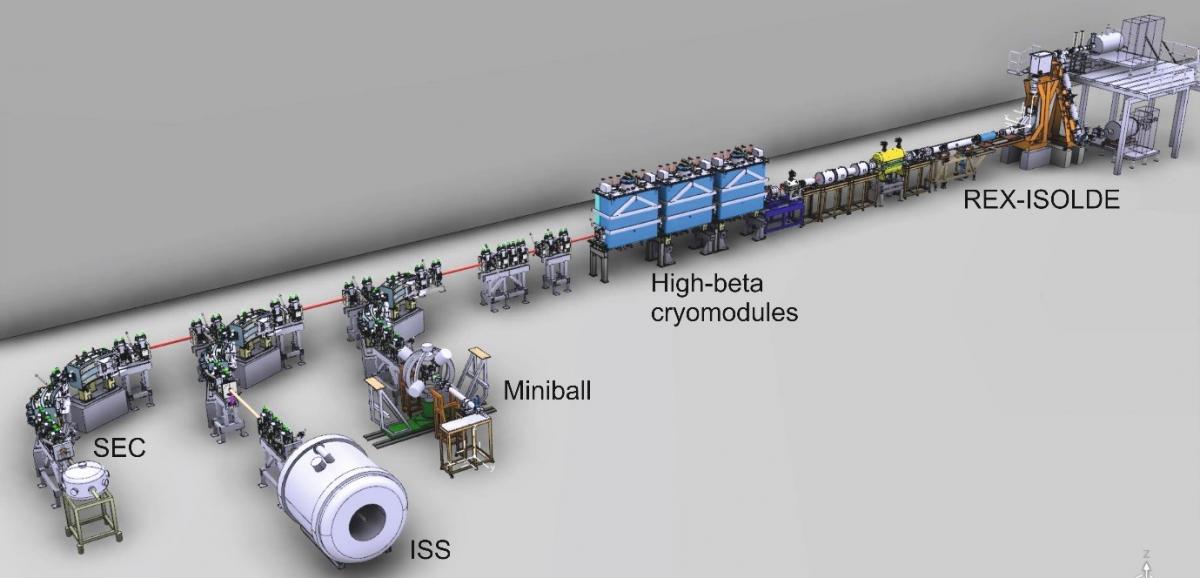HIE-ISOLDE is tuning up for the new physics season
This year has been a busy one for HIE-ISOLDE, the high energy and intensity upgrade project at ISOLDE. In January 2017, another milestone was reached with the addition of the third cryomodule to the HIE-ISOLDE linear post-accelerator, increasing the energy of radioactive ion beams from 5.5 to up to 7.5 MeV per nucleon. The facility has been a hive of activity for the past few months, as a new detector was installed and the cryogenics system was upgraded with state-of-the-art equipment, while commissioning for this year’s physics run is well underway.

Figure 1 The 3rd HIE-ISOLDE cryomodule is now in its final position in the ISOLDE hall
ISOLDE, the nuclear physics facility at CERN, has been in operation for fifty years and can produce the widest range of radioactive isotopes worldwide. The secret of its success and longevity is its ability to adapt and grow to accommodate the requirements of the changing physics landscape. The HIE-ISOLDE project, as part of this approach, aims to extend the energy and intensity of the radioactive ion beams, opening up new physics opportunities for the upgraded facility. The energy upgrade comprises the construction of linear accelerator consisting of four high-beta and two low-beta cryomodules. It would gradually increase the energy of the radioactive beams produced at ISOLDE from 3 up to 10 MeV per nucleon for the heaviest elements and provide full energy variability starting at 0.3 MeV per nucleon.
Following extensive R&D work in the previous years, two high-beta cryomodules were manufactured and installed during 2015 and 2016. The first physics runs at the upgraded facility proved especially promising; for example, Coulomb excitation of a 142Xe beam showed a marked improvement in the population of higher lying states. In accordance with the upgrade schedule, the third cryomodule was added this January. The good coordination of the installation team ensured that everything went smoothly, despite the challenging winter conditions. The extension of the linac means that now experimental teams coming to ISOLDE can request beams with energies up to 7.5 MeV per nucleon for A/q = 4.5, further extending the wide range of experiments that take place at the facility.

Figure 2 A 3D visual of the HIE-ISOLDE linac, composed of three cryomodules, and three experimental stations. At the end of the first beam line, Miniball is located, at the second, the ISOL Solenoidal Spectrometer, ISS, and the third is reserved for movable setups. In the drawing, it is occupied by the ScattEring Chamber, SEC.
This year also saw the installation of one additional experimental station besides the Miniball germanium detector array and the SEC scattering chamber (Figure 2). The ISOL Solenoidal Spectrometer is a project that brought new life to a retired MRI scanner coming all the way from an Australian hospital. The powerful magnet underwent extensive work to become operational again and was moved to the ISOLDΕ hall in March. It will be used to explore the nuclear reactions that occur when stars explode in supernovae. In addition, extensive work was done to improve the operation and safety of the post accelerator during the extended year-end technical stop at CERN, mainly at the cryogenics system and beam transfer lines.
The HIE-ISOLDE team has worked tirelessly since March to prepare the facility for the new physics run with post-accelerated beams, set to begin in early July. The low-energy experiments period started, as scheduled, in April. Thirteen experiments have already been scheduled for the HIE-ISOLDE run, studying a wide range of isotopes, from the lightest, e.g. 7Li, to heavy ones like 206Hg. They aim to explore a wide range of topics, such as testing nuclear structure models, improving the predictive power of the shell model for exotic nuclei, as well as investigating novel radionuclides with diagnostic and therapeutic properties for medical applications.
The second phase of the HIE-ISOLDE energy upgrade will be completed in 2018 with the addition of a fourth high-beta cryomodule that will allow radioactive beams to reach energies between 10 and 15 MeV per nucleon, depending on their mass. This will open up new physics opportunities and make ISOLDE the only facility in the world capable of accelerating heavy radioactive isotopes in this energy range.
